High-Resolution Gridded Air Temperature Data for the Urban Environment: The Milan Data Set
Abstract
:1. Introduction
2. Materials and Methods
2.1. Improving the Observational Air Temperature Resolution
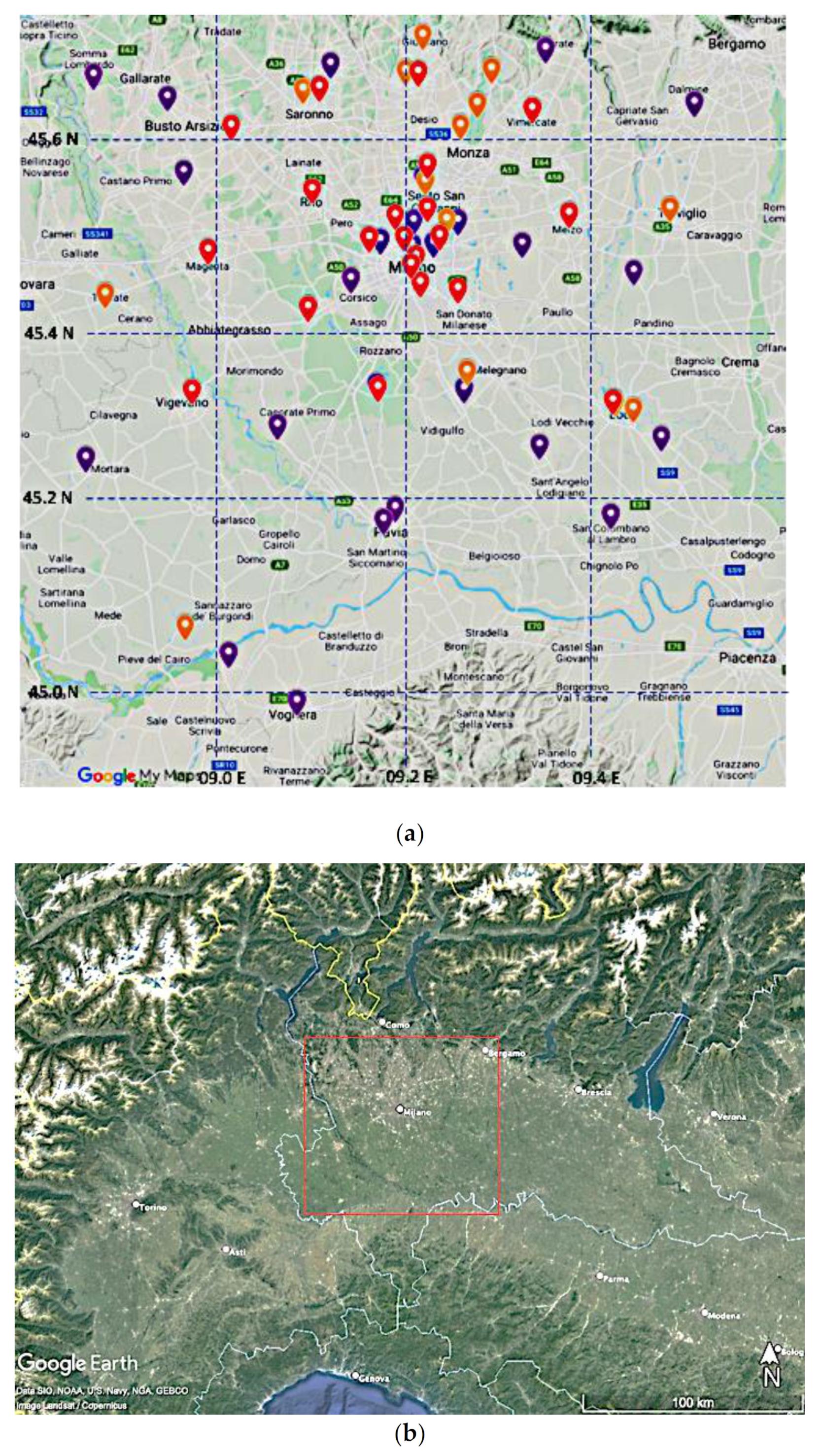
2.2. Data Set of Gridded Air Temperatures for Milan Metropolitan Area
- The surface meteorological database, composed of 10 min mean values obtained by:
- −
- 21 AWSs of the FOMD Network;
- −
- 26 AWSs of the institutional regional network managed by ARPA Lombardia;
- −
- 14 stations of the MeteoNetwork.
- b.
- The LST database, created by the selection of cloud-free spaceborne observations of the Milan area by two different operational platforms:
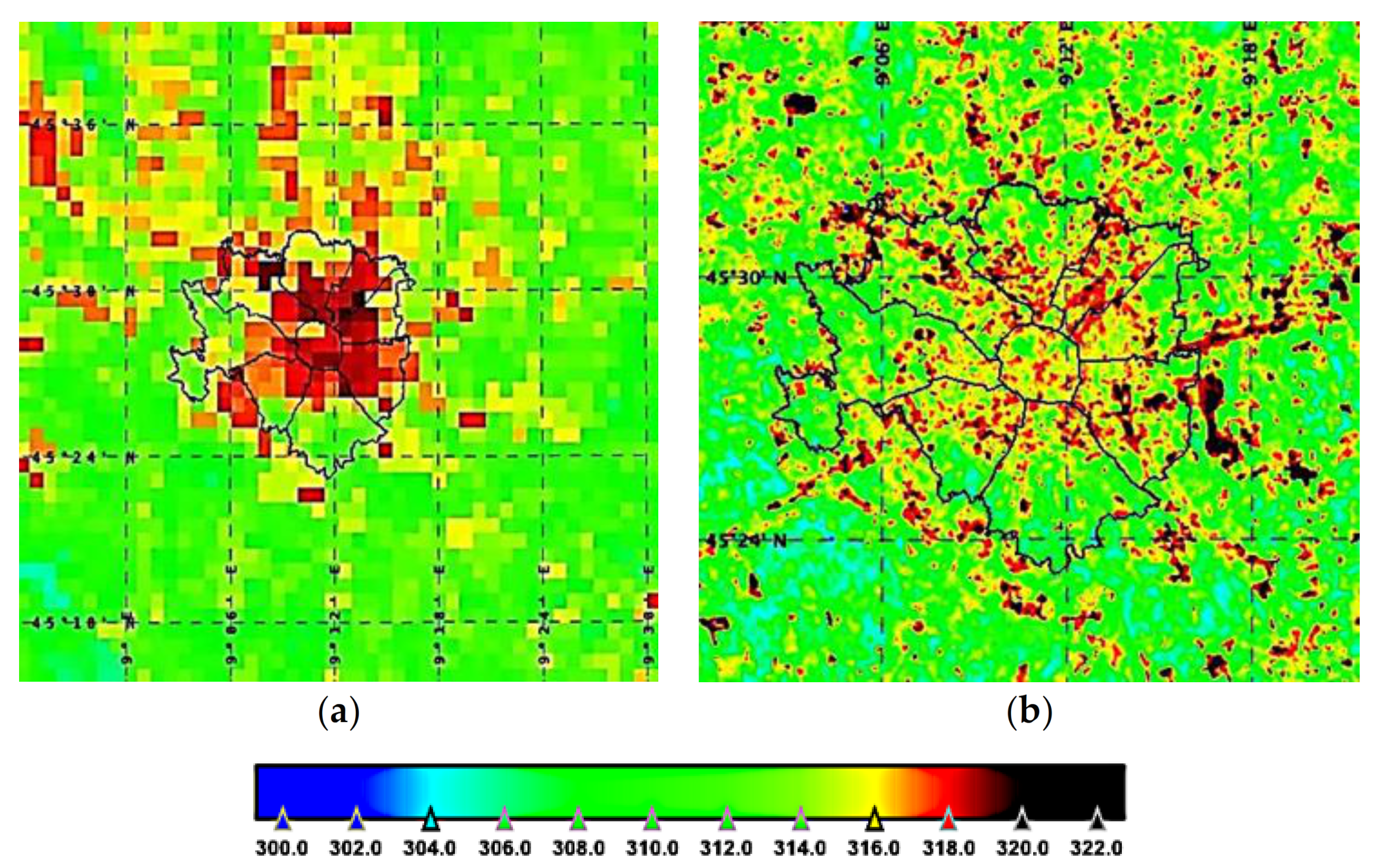
| No. | Date (d/m/y) | UTC | HW | Sat. | No. | Date (d/m-/y) | UTC | HW | Sat. | No. | Date (d/m/y) | UTC | HW | Sat. |
|---|---|---|---|---|---|---|---|---|---|---|---|---|---|---|
| 1 | 19/07/2014 | 10:00 | L8 | 36 | 17/08/2017 | 21:10 | S3 | 71 | 08/06/2019 | 10:04 | L8 | |||
| 2 | 15/07/2015 | 10:00 | √ | L8 | 37 | 21/08/2017 | 10:04 | L8 | 72 | 24/06/2019 | 10:04 | L8 | ||
| 3 | 22/07/2015 | 10:00 | √ | L8 | 38 | 22/08/2017 | 20:50 | S3 | 73 | 26/06/2019 | 09:30 | √ | S3 | |
| 4 | 06/06/2016 | 10:10 | L8 | 39 | 28/08/2017 | 21:30 | S3 | 74 | 26/06/2019 | 19:30 | √ | S3 | ||
| 5 | 15/06/2016 | 10:04 | L8 | 40 | 29/08/2017 | 21:00 | S3 | 75 | 26/06/2019 | 20:00 | S3 | |||
| 6 | 22/06/2016 | 21:30 | S3 | 41 | 06/12/2017 | 10:10 | S3 | 76 | 01/07/2019 | 09:40 | √ | S3 | ||
| 7 | 22/06/2016 | 10:10 | L8 | 42 | 25/12/2017 | 10:20 | S3 | 77 | 01/07/2019 | 10:11 | √ | L8 | ||
| 8 | 23/06/2016 | 21:00 | S3 | 43 | 30/12/2017 | 21:10 | S3 | 78 | 02/07/2019 | 10:40 | √ | S3 | ||
| 9 | 01/07/2016 | 10:04 | L8 | 44 | 19/01/2018 | 21:00 | S3 | 79 | 05/07/2019 | 09:40 | √ | S3 | ||
| 10 | 08/07/2016 | 10:10 | L8 | 45 | 05/06/2018 | 10:03 | L8 | 80 | 05/07/2019 | 21:00 | √ | S3 | ||
| 11 | 09/07/2016 | 20:50 | S3 | 46 | 21/06/2018 | 10:04 | L8 | 81 | 06/07/2019 | 09:10 | √ | S3 | ||
| 12 | 17/07/2016 | 20:40 | S3 | 47 | 21/06/2018 | 10:04 | L8 | 82 | 10/07/2019 | 10:05 | L8 | |||
| 13 | 17/07/2016 | 10:05 | L8 | 48 | 29/06/2018 | 21:20 | S3 | 83 | 16/07/2019 | 20:40 | S3 | |||
| 14 | 20/07/2016 | 09:40 | √ | S3 | 49 | 07/07/2018 | 21:10 | S3 | 84 | 17/07/2019 | 10:10 | L8 | ||
| 15 | 20/07/2016 | 21:00 | √ | S3 | 50 | 07/07/2018 | 10:04 | L8 | 85 | 19/07/2019 | 21:00 | S3 | ||
| 16 | 24/07/2016 | 10:11 | L8 | 51 | 13/07/2018 | 09:30 | S3 | 86 | 21/07/2019 | 09:20 | √ | S3 | ||
| 17 | 02/08/2016 | 10:04 | L8 | 52 | 14/07/2018 | 10:10 | L8 | 87 | 21/07/2019 | 20:50 | √ | S3 | ||
| 18 | 09/08/2016 | 10:10 | L8 | 53 | 19/07/2018 | 21:00 | √ | S3 | 88 | 22/07/2019 | 10:00 | √ | S3 | |
| 19 | 13/08/2016 | 20:40 | S3 | 54 | 23/07/2018 | 10:04 | L8 | 89 | 23/07/2019 | 21:00 | S3 | |||
| 20 | 18/08/2016 | 10:04 | L8 | 55 | 30/07/2018 | 10:10 | √ | L8 | 90 | 26/07/2019 | 10:00 | √ | S3 | |
| 21 | 24/08/2016 | 21:00 | S3 | 56 | 31/07/2018 | 20:50 | √ | S3 | 91 | 26/07/2019 | 10:05 | √ | L8 | |
| 22 | 25/08/2016 | 10:10 | L8 | 57 | 07/08/2018 | 09:50 | √ | S3 | 92 | 01/08/2019 | 21:00 | S3 | ||
| 23 | 05/12/2016 | 10:00 | S3 | 58 | 08/08/2018 | 10:03 | √ | L8 | 93 | 02/08/2019 | 10:10 | L8 | ||
| 24 | 30/12/2016 | 20:40 | S3 | 59 | 10/08/2018 | 21:30 | S3 | 94 | 08/08/2019 | 21:40 | S3 | |||
| 25 | 01/01/2017 | 10:00 | S3 | 60 | 11/08/2018 | 21:10 | S3 | 95 | 08/08/2019 | 20:40 | S3 | |||
| 26 | 24/01/2017 | 10:00 | S3 | 61 | 15/08/2018 | 10:10 | L8 | 96 | 11/08/2019 | 10:04 | L8 | |||
| 27 | 29/01/2017 | 21:00 | S3 | 62 | 18/08/2018 | 21:30 | S3 | 97 | 15/08/2019 | 21:00 | S3 | |||
| 28 | 02/06/2017 | 10:04 | L8 | 63 | 22/08/2018 | 21:20 | S3 | 98 | 18/08/2019 | 10:10 | L8 | |||
| 29 | 08/06/2017 | 21:30 | S3 | 64 | 23/08/2018 | 20:50 | √ | S3 | 99 | 22/08/2019 | 21:00 | S3 | ||
| 30 | 18/06/2017 | 10:04 | L8 | 65 | 24/08/2018 | 10:04 | L8 | 100 | 24/08/2019 | 21:10 | S3 | |||
| 31 | 03/07/2017 | 20:40 | S3 | 66 | 16/01/2019 | 09:50 | S3 | 101 | 27/08/2019 | 10:04 | L8 | |||
| 32 | 04/07/2017 | 10:04 | L8 | 67 | 20/01/2019 | 09:40 | S3 | 102 | 29/08/2019 | 20:40 | S3 | |||
| 33 | 27/07/2017 | 10:11 | L8 | 68 | 08/02/2019 | 09:50 | S3 | 103 | 08/07/2108 | 20:50 | S3 | |||
| 34 | 05/08/2017 | 10:04 | √ | L8 | 69 | 13/02/2019 | 20:40 | S3 | ||||||
| 35 | 12/08/2017 | 10:10 | L8 | 70 | 17/02/2019 | 20:40 | S3 |
| Day Time | Season | Max Temperature | Thermal Weather | Relative Frequency |
|---|---|---|---|---|
| Morning | Summer | City Center | HW | 84% |
| Morning | Summer | North_East | HW | 2% |
| Morning | Summer | North_West | HW | 13% |
| Evening | Summer | City Center | HW | 75.3% |
| Evening | Summer | North_East | HW | 19.4% |
| Evening | Summer | North_West | HW | 5.3% |
| Evening | Summer | City Center | UHI | 61.0% |
| Evening | Summer | East | UHI | 18% |
| Evening | Summer | North_West | UHI | 21% |
| Morning | Winter | City Center | UHI | 65% |
| Morning | Winter | North_East | UHI | 19% |
| Morning | Winter | West | UHI | 16% |
| Evening | Winter | City Center | UHI | 81% |
| Evening | Winter | East | UHI | 19% |
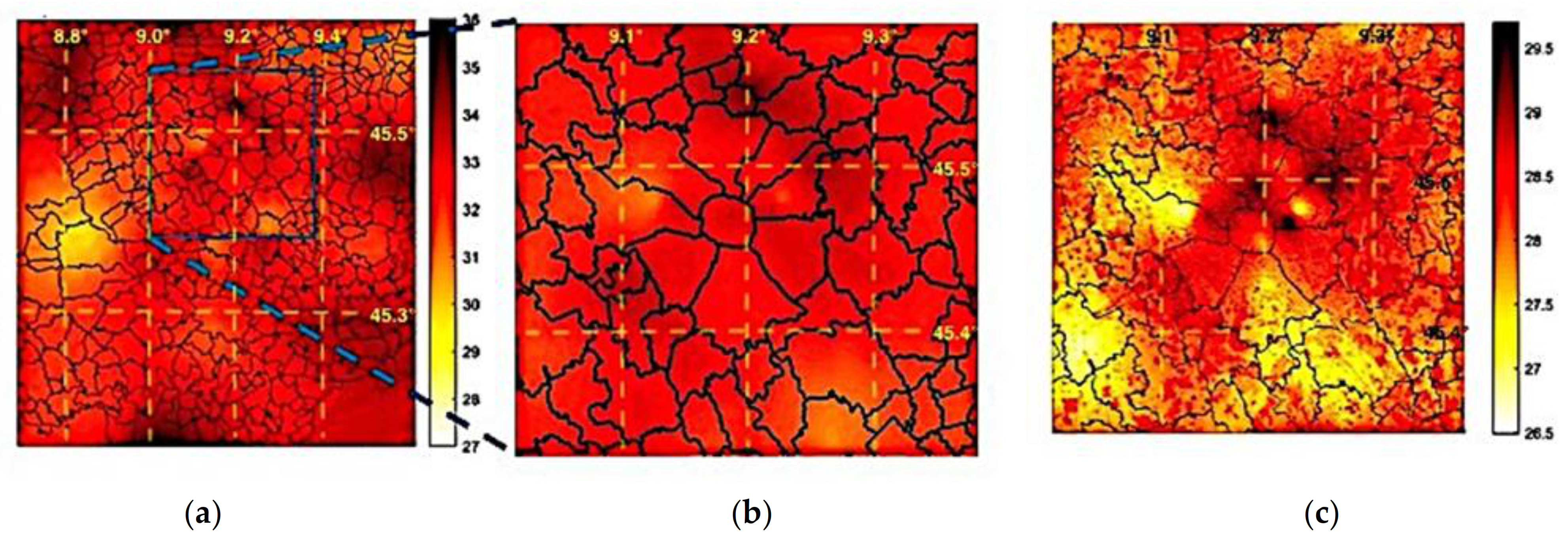

2.3. Comparison with Other Data Sets
2.3.1. Comparison with ERA5/UrbClim
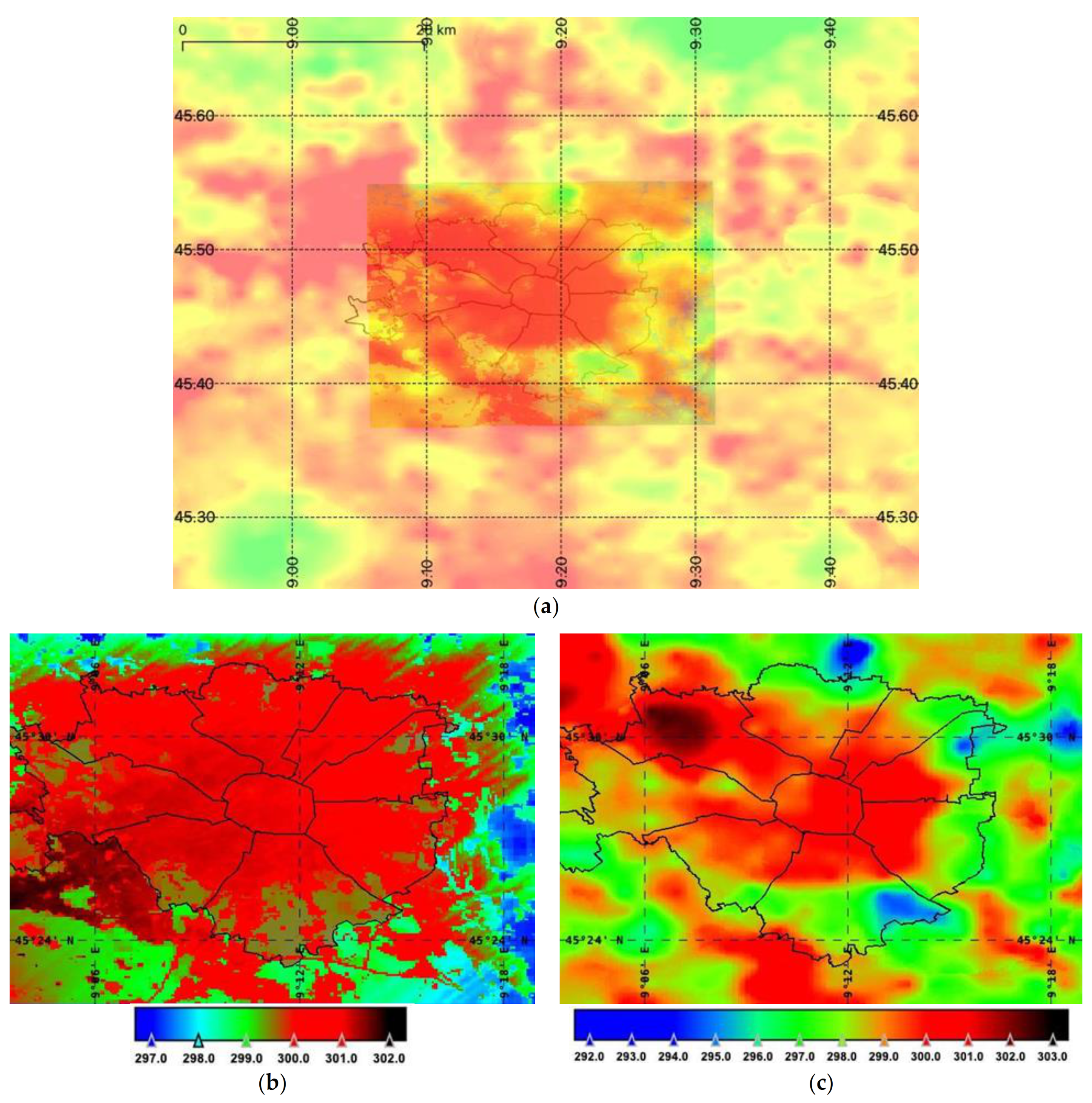
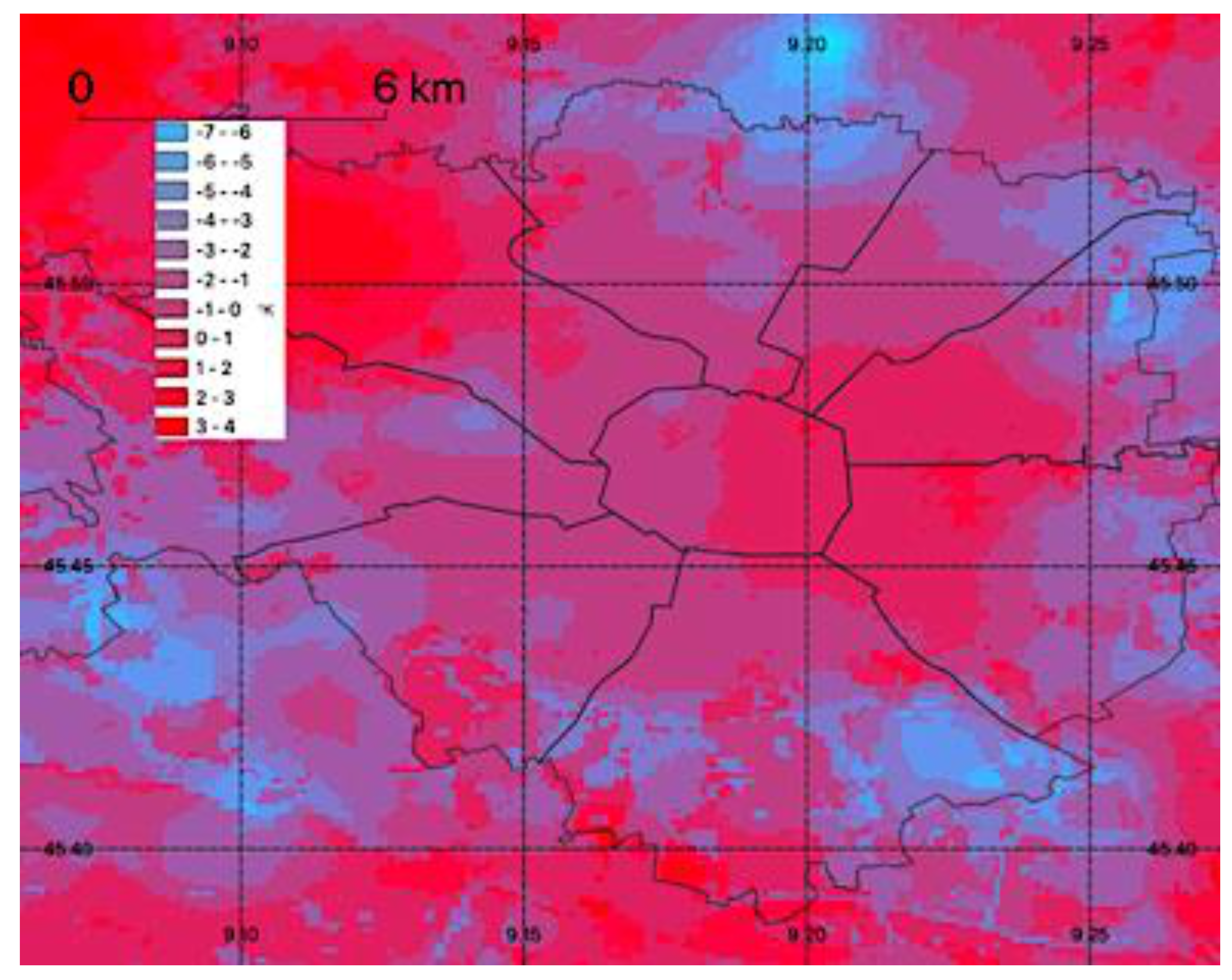
2.3.2. Comparison with the Weather Research and Forecasting Model
3. Results
3.1. Comparison Results: ERA5/UrbClim
| No. | Date (d/m/y) | COK UTC | Diff. Min. (°C) | Diff. Mean (°C) | Diff. Max. (°C) | Min. Max. Range (°C) | Pearson Corr. R | Cov. | CoK Mean T | UrC Mean T | Mean T diff. CoK–UrC | HW/Season |
|---|---|---|---|---|---|---|---|---|---|---|---|---|
| 1 | 22/6/2016 | 21:30 | −9.5 | −3.1 ± 1.5 | 2.7 | 12.2 | 0.50 | 1.1 | 25.5 ± 1.4 | 28.6 ± 1.6 | −3.1 | Summer |
| 2 | 23/6/2016 | 21:00 | −7.9 | −3.0 ± 1.7 | 2.9 | 10.8 | 0.32 | 0.6 | 27.1 ± 1.2 | 28.6 ± 1.6 | −1.5 | Summer |
| 3 | 9/7/2016 | 20:50 | −5.6 | −1.5 ± 1.4 | 3.2 | 8.8 | 0.19 | 0.2 | 28.2 ± 1.1 | 28.2 ± 1.1 | 0.0 | Summer |
| 4 | 17/7/2016 | 20:40 | −11.5 | −5.0 ± 1.7 | 0.5 | 12.0 | 0.31 | 0.6 | 25.3 ± 1.5 | 28.8 ± 1.3 | −3.4 | Summer |
| 5 | 20/7/2016 | 09:40 | 0.0 | 2.5 ± 1.1 | 5.7 | 5.8 | 0.26 | 0.2 | 29.9 ± 0.9 | 25.9 ± 1.0 | 3.9 | HW |
| 6 | 20/7/2016 | 21:00 | −5.3 | −1.2 ± 1.4 | 3.6 | 9.0 | 0.35 | 0.3 | 27.3 ± 1.2 | 27.1 ± 1.2 | 0.3 | HW |
| 7 | 13/8/2016 | 20:40 | −9.9 | −6.0 ± 1.4 | −1.5 | 8.4 | 0.38 | 0.6 | 22.6 ± 1.2 | 27.1 ± 1.4 | −4.5 | Summer |
| 8 | 5/12/2016 | 10:00 | −4.4 | 0.1 ± 2.0 | 4.9 | 9.3 | −0.05 | −0.1 | 7.0 ± 1.2 | 5.5 ± 1.6 | 1.5 | Winter |
| 9 | 30/12/2016 | 20:40 | −8.0 | −3.2 ± 2.2 | 5.0 | 13.0 | 0.45 | 1.4 | 2.0 ± 1.2 | 3.8 ± 2.5 | −1.8 | Winter |
| 10 | 1/1/2017 | 10:00 | −8.4 | −2.2 ± 2.5 | 3.8 | 12.2 | −0.02 | −0.1 | 1.7 ± 1.8 | 2.5 ± 1.7 | −0.8 | Winter |
| 11 | 24/1/2017 | 10:00 | 1.3 | 4.2 ± 1.5 | 8.9 | 7.6 | −0.21 | 0.3 | 7.3 ± 1.2 | 1.7 ± 1.1 | 5.5 | Winter |
| 12 | 29/1/2017 | 21:00 | −7.3 | −3.6 ± 1.0 | −1.0 | 6.3 | 0.60 | 0.7 | 2.1 ± 1.2 | 4.3 ± 1.0 | −2.2 | Winter |
| 13 | 8/6/2017 | 21:30 | −8.4 | −4.8 ± 1.4 | 0.2 | 8.6 | 0.27 | 0.4 | 19.8 ± 1.1 | 23.1 ± 1.3 | −3.3 | Summer |
| 14 | 3/7/2017 | 21:40 | −7.4 | −1.4 ± 1.3 | 3.8 | 11.2 | 0.45 | 0.7 | 25.5 ± 1.4 | 25.4 ± 1.1 | 0.1 | Summer |
| 15 | 17/8/2017 | 21:10 | −8.1 | −3.4 ± 1.2 | 2.7 | 10.8 | 0.18 | 0.3 | 26.9 ± 1.2 | 28.8 ± 1.3 | −1.9 | Summer |
| 16 | 22/8/2017 | 20:50 | −9.5 | −5.6 ± 1.2 | −1.0 | 8.5 | 0.54 | 0.8 | 22.7 ± 1.1 | 26.8 ± 1.4 | −4.1 | Summer |
| 17 | 28/8/2017 | 21:30 | −4.4 | −1.5 ± 1.1 | 2.9 | 7.2 | 0.45 | 0.4 | 27.0 ± 0.8 | 27.0 ± 1.2 | 0.0 | Summer |
| 18 | 29/8/2017 | 21:00 | −8.7 | −4.4 ± 1.3 | −0.2 | 8.5 | 0.51 | 0.8 | 25.4 ± 1.3 | 28.3 ± 1.3 | −2.9 | Summer |
| 19 | 6/12/2017 | 10:10 | −4.2 | 1.7 ± 2.1 | 7.3 | 11.4 | 0.10 | 0.2 | 7.6 ± 1.7 | 4.5 ± 1.3 | 3.1 | Winter |
| 20 | 25/12/2017 | 10:20 | −1.9 | 1.8 ± 1.2 | 5.1 | 7.0 | 0.44 | 0.4 | 7.8 ± 1.3 | 4.6 ± 0.7 | 3.2 | Winter |
| 21 | 30/12/2017 | 21:10 | −6.8 | −3.1 ± 1.2 | −0.4 | 6.3 | 0.44 | 0.5 | 2.6 ± 0.9 | 4.3 ± 1.2 | −1.7 | Winter |


| No. | Date (d/m/y) | UTC | Milano Città Studi | Milano Bovisa | Milano Centro | Milano S. Siro | Milano Sud | Milano Bocconi | Milano Bicocca | Milano Sarpi | Cinisello Parco Nord | Corsico | Milano Lambrate | Milano Brera | Milano Juvara | Milano Marche | Milano Zavattari | Sesto S. Giovanni Parco Nord | Milano Maxwell | Mean | Std. Dev. | Min. | Max. |
|---|---|---|---|---|---|---|---|---|---|---|---|---|---|---|---|---|---|---|---|---|---|---|---|
| 1 | 22/06/2016 | 21:30 | −2.3 | −3.2 | −2.4 | −3.2 | −3.2 | −2.8 | −2.6 | −2.7 | −7.2 | −8.3 | −4.7 | −2.5 | −2.4 | −4.1 | −6.9 | −2.2 | −0.4 | −3.6 | 2.1 | −8.3 | −0.4 |
| 2 | 23/06/2016 | 21:00 | −1.9 | −1.8 | −2.8 | −3.5 | −3.3 | −3.1 | −2.0 | −3.0 | −6.1 | −7.3 | −5.4 | −2.9 | −2.2 | −4.2 | −5.6 | −4.2 | −4.0 | −3.7 | 1.6 | −7.3 | −1.8 |
| 3 | 09/07/2016 | 20:50 | −0.9 | −0.6 | −0.9 | −2.0 | −1.9 | −1.4 | −0.9 | −0.9 | −4.1 | −5.1 | −4.2 | −0.6 | −0.8 | −1.2 | −2.8 | −1.3 | −3.0 | −1.9 | 1.4 | −5.1 | −0.6 |
| 4 | 17/07/2016 | 20:40 | −5.0 | −4.9 | −4.8 | −4.8 | −6.0 | −5.2 | −5.0 | −4.8 | −11.9 | −7.2 | −9.7 | −4.4 | −5.0 | −5.4 | −6.5 | −8.7 | −6.3 | −6.2 | 2.1 | −11.9 | −4.4 |
| 5 | 20/07/2016 | 09:40 | −0.1 | 1.7 | 0.9 | 4.8 | 0.1 | 0.7 | 1.1 | 0.5 | 4.3 | 3.1 | 3.0 | 1.4 | 0.4 | 1.9 | 2.4 | 2.5 | 1.9 | 1.8 | 1.4 | −0.1 | 4.8 |
| 6 | 20/07/2016 | 21:00 | −0.3 | −0.1 | −0.8 | −1.3 | −1.8 | −1.3 | 0.4 | −0.4 | −5.4 | −2.4 | −3.0 | −0.1 | −0.4 | −0.1 | −2.3 | −1.3 | −0.9 | −1.2 | 1.4 | −5.4 | 0.4 |
| 7 | 13/08/2016 | 20:40 | −5.4 | −5.2 | −5.2 | −6.7 | −6.2 | −5.8 | −5.3 | −5.7 | −9.6 | −9.5 | −9.2 | −4.4 | −5.2 | −6.8 | −8.2 | −7.4 | −7.0 | −6.6 | 1.6 | −9.6 | −4.4 |
| 8 | 05/12/2016 | 10:00 | −2.0 | 0.9 | 0.1 | 3.3 | −1.3 | −0.1 | 0.2 | 0.7 | 1.1 | 0.5 | −1.9 | 1.2 | −0.4 | −0.7 | 2.5 | 0.2 | −1.8 | 0.2 | 1.5 | −2.0 | 3.3 |
| 9 | 30/12/2016 | 20:40 | −2.5 | −5.8 | −2.9 | −5.4 | −4.7 | −3.9 | −4.6 | −4.1 | −3.1 | −6.1 | −2.3 | −3.5 | −2.4 | −4.8 | −6.6 | −1.9 | −1.8 | −3.9 | 1.5 | −6.6 | −1.8 |
| 10 | 01/01/2017 | 10:00 | −1.1 | 0.0 | −1.9 | −1.7 | −4.9 | −3.3 | 0.6 | −1.4 | 0.3 | −0.7 | −2.8 | −2.5 | −0.3 | −2.6 | −0.3 | −0.2 | −0.5 | −1.3 | 1.5 | −4.9 | 0.6 |
| 11 | 24/01/2017 | 10:00 | 2.9 | 4.1 | 3.8 | 6.0 | 2.1 | 3.1 | 3.0 | 4.7 | 6.0 | 4.0 | 5.5 | 2.3 | 2.9 | 1.4 | 4.5 | 4.7 | 4.7 | 3.9 | 1.4 | 1.4 | 6.0 |
| 12 | 29/01/2017 | 21:00 | −2.3 | −2.5 | −2.1 | −3.1 | −2.3 | −1.7 | −2.6 | −1.7 | −6.5 | −5.6 | −5.6 | −1.9 | −2.0 | −3.0 | −3.4 | −3.5 | −2.9 | −3.1 | 1.5 | −6.5 | −1.7 |
| 13 | 08/06/2017 | 21:30 | −3.7 | −4.0 | −3.8 | −4.1 | −5.0 | −4.2 | −3.3 | −3.8 | −7.8 | −6.6 | −7.3 | −3.7 | −3.8 | −4.5 | −6.3 | −5.8 | −5.7 | −4.9 | 1.4 | −7.8 | −3.3 |
| 14 | 03/07/2017 | 21:40 | −0.1 | −1.1 | −0.3 | −1.5 | −2.3 | −1.1 | −1.4 | −0.9 | −7.3 | −4.0 | −5.2 | −0.3 | −0.2 | −2.3 | −3.6 | −4.1 | −2.3 | −2.2 | 2.0 | −7.3 | −0.1 |
| 15 | 17/08/2017 | 21:10 | −2.2 | −2.1 | −2.4 | −2.6 | −4.6 | −2.9 | −1.6 | −1.9 | −5.8 | −5.9 | −5.4 | −2.4 | −2.1 | −2.9 | −5.2 | −3.3 | −3.3 | −3.3 | 1.5 | −5.9 | −1.6 |
| 16 | 22/08/2017 | 20:50 | −4.4 | −5.3 | −4.6 | −6.3 | −5.9 | −5.3 | −4.7 | −4.6 | −9.5 | −8.0 | −7.9 | −4.4 | −3.9 | −5.3 | −7.9 | −7.2 | −5.9 | −5.9 | 1.6 | −9.5 | −3.9 |
| 17 | 28/08/2017 | 21:30 | −1.5 | −1.4 | −1.7 | −1.7 | −2.3 | −1.7 | −1.5 | −1.3 | −2.1 | −3.4 | −1.5 | −1.3 | −1.2 | −1.4 | −4.1 | −3.2 | −2.1 | −1.9 | 0.8 | −4.1 | −1.2 |
| 18 | 29/08/2017 | 21:00 | −3.5 | −3.7 | −3.3 | −4.0 | −3.7 | −3.5 | −3.6 | −3.2 | −8.3 | −6.7 | −6.7 | −3.3 | −3.4 | −4.5 | −6.3 | −6.3 | −4.6 | −4.6 | 1.6 | −8.3 | −3.2 |
| 19 | 06/12/2017 | 10:10 | 0.8 | 2.2 | 2.2 | 2.0 | 0.2 | 1.4 | 2.4 | 1.4 | 2.8 | 2.6 | 2.5 | −0.2 | 1.6 | −0.5 | 2.3 | −5.1 | 0.9 | 1.2 | 1.9 | −5.1 | 2.8 |
| 20 | 25/12/2017 | 10:20 | 3.4 | 1.6 | 2.5 | 1.1 | 1.0 | 1.9 | 1.7 | 2.1 | 2.4 | 1.5 | 3.8 | 2.4 | 3.6 | 1.2 | 2.3 | −5.9 | 3.7 | 1.8 | 2.2 | −5.9 | 3.8 |
| 21 | 30/12/2017 | 21:10 | −1.5 | −3.4 | −1.3 | −4.2 | −2.4 | −1.7 | −2.2 | −2.4 | −6.6 | −4.1 | −3.7 | −1.9 | −1.3 | −2.6 | −5.2 | −6.2 | −1.1 | −3.0 | 1.7 | −6.6 | −1.1 |
| No. | Date | Time (UTC) | Fuzzy Num. Average | Fuzzy Global Matching | Moran’s I (Map1*Map2) | Mean Cross Moran | R Lagged | Lee’s L |
|---|---|---|---|---|---|---|---|---|
| 1 | 2016/06/22 | 21:30 | 0.99 | 0.20 | 0.96 | 0.48 | 0.6 | 0.51 |
| 2 | 2016/06/23 | 21:00 | 0.99 | 0.19 | 0.96 | 0.32 | 0.4 | 0.33 |
| 3 | 2016/07/09 | 20:50 | 1.00 | 0.23 | 0.97 | 0.17 | 0.2 | 0.17 |
| 4 | 2016/07/17 | 20:40 | 0.98 | 0.16 | 0.97 | 0.28 | 0.3 | 0.29 |
| 5 | 2016/07/20 | 09:40 | 0.99 | 0.18 | 0.99 | 0.25 | 0.3 | 0.26 |
| 6 | 2016/07/20 | 21:00 | 1.00 | 0.33 | 0.95 | 0.33 | 0.4 | 0.36 |
| 7 | 2016/08/13 | 20:40 | 0.98 | 0.17 | 0.96 | 0.36 | 0.4 | 0.38 |
| 9 | 2016/12/30 | 20:40 | 0.99 | 0.21 | 0.96 | 0.43 | 0.5 | 0.45 |
| 11 | 2017/01/24 | 10:00 | 0.98 | 0.17 | 0.97 | 0.41 | 0.5 | 0.43 |
| 13 | 2017/06/08 | 21:30 | 0.98 | 0.17 | 0.93 | 0.27 | 0.4 | 0.31 |
| 14 | 2017/07/03 | 21:40 | 0.98 | 0.18 | 0.94 | 0.27 | 0.3 | 0.28 |
| 16 | 2017/08/22 | 20:50 | 1.00 | 0.26 | 0.94 | 0.34 | 0.4 | 0.37 |
| 20 | 2017/12/25 | 10:20 | 0.99 | 0.23 | 0.99 | 0.44 | 0.5 | 0.45 |
| Settings: | Radius = 4; exp. decay halving dist. = 2 | First raster (CoK) as reference | Radius =10 | |||||
3.2. Comparison Results: WRF
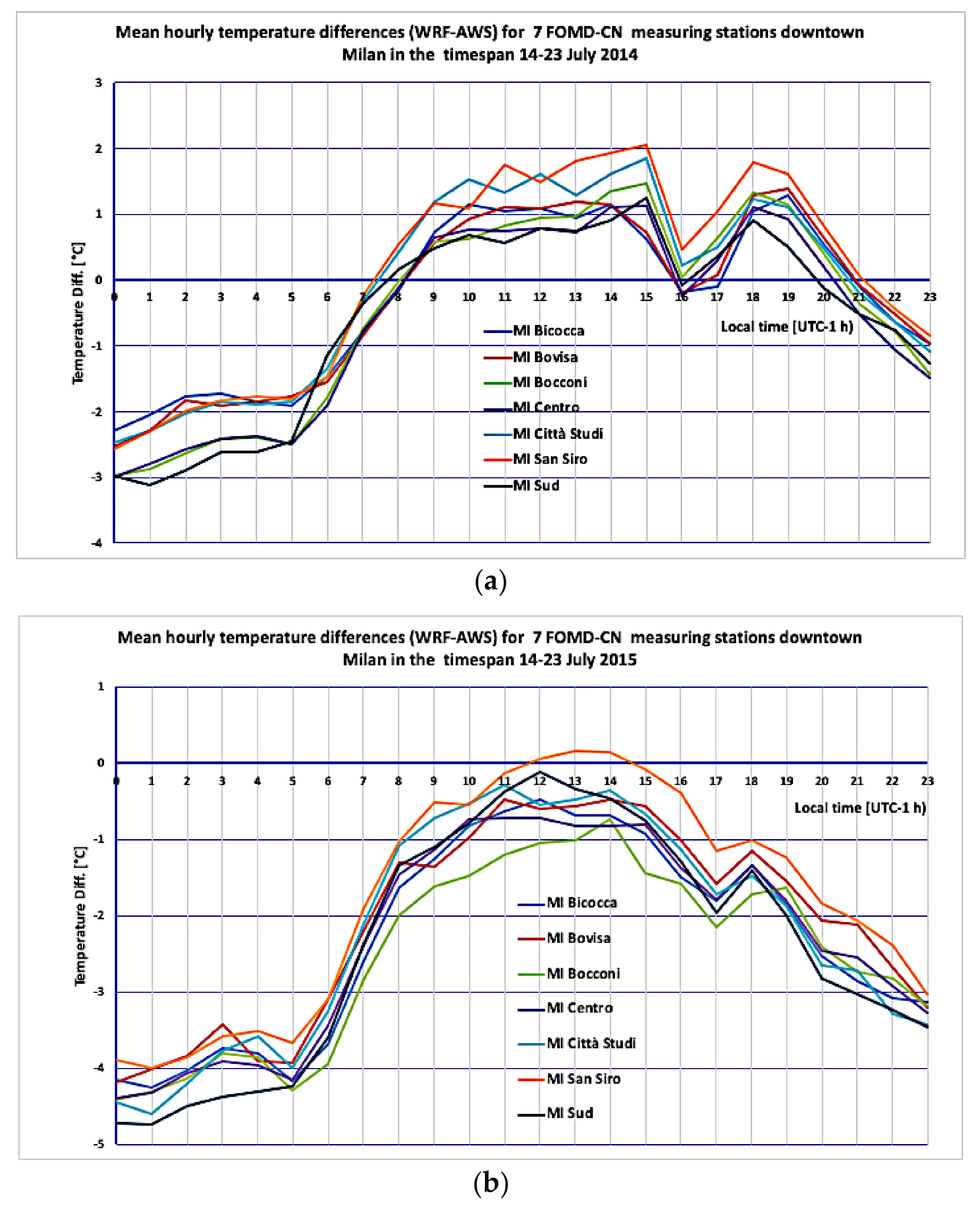

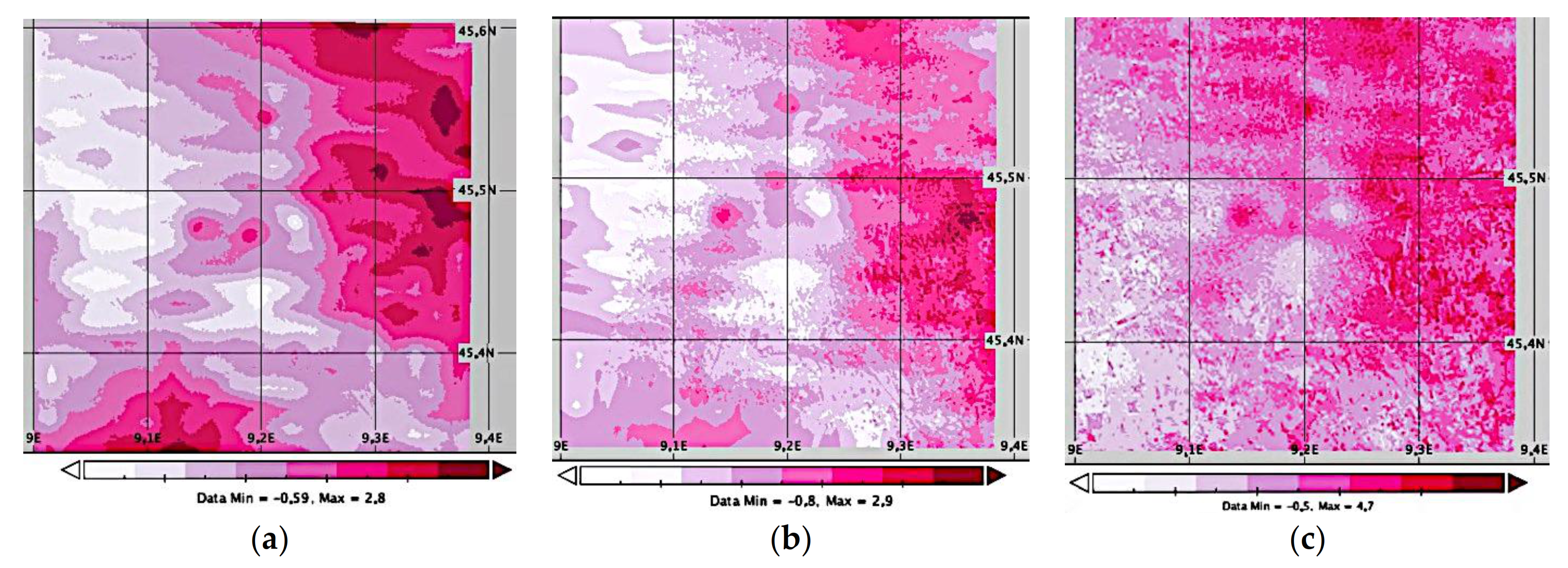
4. Discussion
5. Conclusions
Author Contributions
Funding
Institutional Review Board Statement
Informed Consent Statement
Data Availability Statement
Acknowledgments
Conflicts of Interest
References
- Santamouris, M. Recent progress on urban overheating and heat island research. Integrated assessment of the energy, environmental, vulnerability and health impact. Synergies with the global climate change. Energy Build. 2020, 207, 109482. [Google Scholar] [CrossRef]
- Oke, T.R.; Mills, G.; Christen, A.; Voogt, J.A. Urban Climates; Cambridge University Press: Cambridge, UK, 2017. [Google Scholar] [CrossRef] [Green Version]
- WMO. Guide to Instruments and Methods of Observation (CIMO Guide), 2018, WMO-No. 8. Available online: https://library.wmo.int/index.php?lvl=notice_display&id=12407#.XiGSwf5KiUk (accessed on 28 December 2021).
- Oke, T.R. Siting and Exposure of Meteorological Instruments at Urban Sites. In Air Pollution Modelling and Its Application XVII; Springer: Berlin/Heidelberg, Germany, 2007; pp. 615–632. [Google Scholar] [CrossRef]
- Mills, G.; Cleugh, H.; Emmanuel, R.; Endlicher, W.; Erell, E.; McGranahan, G.; Ng, E.; Nickson, A.; Rosenthal, J.; Steemer, K. Climate Information for Improved Planning and Management of Mega Cities (Needs Perspective). Procedia Environ. Sci. 2010, 1, 228–246. [Google Scholar] [CrossRef] [Green Version]
- Muller, C.L.; Chapman, L.; Grimmond, C.S.B.; Young, D.T.; Cai X-M. Sensors and the city: A review of urban meteorological networks. Int. J. Climatol. 2013, 33, 1585–1600. [Google Scholar] [CrossRef]
- Hulley, G.C.; Ghent, D.; Göttsche, F.M.; Guillevic, P.C.; Mildrexler, D.J.; Coll, C. Land Surface Temperature. In Taking the Temperature of the Earth; Elsevier: Amsterdam, The Netherlands, 2019; pp. 57–127. [Google Scholar] [CrossRef]
- Toparlar, Y.; Blocken, B.; Maiheu, B.; van Heijst, G.J.F. A review on the CFD analysis of urban microclimate. Renew. Sustain. Energy Rev. 2017, 80, 1613–1640. [Google Scholar] [CrossRef]
- Jänicke, B.; Miloševic, D.; Manavvi, S. Review of User-Friendly Models to Improve the Urban Micro-Climate. Atmosphere 2021, 12, 1291. [Google Scholar] [CrossRef]
- Vuckovic, M.; Hammerberg, K.; Mahdavi, A. Urban weather modeling applications: A Vienna case study. Build. Simul. 2020, 13, 99–111. [Google Scholar] [CrossRef] [Green Version]
- Wackernagel, H. Cokriging. In Multivariate Geostatistics; Springer: Berlin/Heidelberg, Germany, 1995. [Google Scholar] [CrossRef]
- Montoli, E.; Frustaci, G.; Lavecchia, C.; Pilati, S. High-resolution climatic characterization of air temperature in the urban canopy layer. Bull. Atmos. Sci. Technol. 2021, 2, 7. [Google Scholar] [CrossRef]
- Stewart, I.D.; Oke, T.R. Local climate zones for urban temperature studies. Bull. Am. Meteorol. Soc. 2012, 93, 1879–1900. [Google Scholar] [CrossRef]
- Chapman, L.; Muller, C.L.; Young, D.T.; Warren, E.L.; Grimmond, C.S.B.; Cai, X.; Ferranti, E.J.S. The Birmingham Urban Climate Laboratory: An Open Meteorological Test Bed and Challenges of the Smart City. Bull. Am. Meteorol. Soc. 2015, 96, 1545–1560. Available online: https://journals.ametsoc.org/view/journals/bams/96/9/bams-d-13-00193.1.xml (accessed on 23 November 2021). [CrossRef]
- Cheval, S.; Micu, D.; Dumitrescu, A.; Irimescu, A.; Frighenciu, M.; Iojă, C.; Tudose, N.C.; Davidescu, Ș.; Antonescu, B. Meteorological and Ancillary Data Resources for Climate Research in Urban Areas. Climate 2020, 8, 37. [Google Scholar] [CrossRef] [Green Version]
- Borghi, S.; Favaron, M.; Frustaci, G. Climate network: A climatological network for energy applications in urban areas. IEEE Instrum. Meas. Mag. 2014, 17, 18–23. [Google Scholar] [CrossRef]
- Curci, S.; Lavecchia, C.; Pilati, S.; Paganelli, C. High quality sustainable monitoring in cities for climatological services. WMO-IOM Report-No 132. In Proceedings of the 2018 WMO/CIMO Technical Conference on Meteorological and Environmental Instruments and Methods of Observation (CIMO-TECO) “Towards Fit-for-Purpose Environmental Measurements”, Amsterdam, The Netherlands, 8–11 October 2018; Available online: https://library.wmo.int/index.php?lvl=notice_display&id=20734#.XAejlq5KuUl (accessed on 15 November 2021).
- Curci, S.; Lavecchia, C.; Frustaci, G.; Paolini, R.; Pilati, S.; Paganelli, C. Assessing measurement uncertainty in meteorology in urban environments. Meas. Sci. Technol. 2017, 28, 104002. [Google Scholar] [CrossRef] [Green Version]
- Frustaci, G.; Pilati, S.; Lavecchia, C. Canopy Urban Heat Island observations in Milano: Methodological aspects and recent climatology. In Proceedings of the European Geosciences Union General Assembly, Vienna, Austria, 7–12 April 2019; Volume 2019, p. 6052. Available online: https://meetingorganizer.copernicus.org/EGU2019/orals/31288 (accessed on 22 April 2021).
- Frustaci, G.; Pilati, S.; Lavecchia, C. Climatology of the Milano Canopy Urban Heat Island by means of an operational urban meteorological network. In Proceedings of the AISAM 2° National Congress, Napoli, Italy, 24–26 September 2019; Available online: https://www.fondazioneomd.it/pubblicazioni (accessed on 22 April 2021).
- Goovaerts, P. Geostatistics in soil science: State-of-the-art and perspectives. Geoderma 1999, 89, 1–45. [Google Scholar] [CrossRef]
- Kilibarda, M.; Hengl, T.; Heuvelink, G.B.M.; Gräler, B.; Pebesma, E.; Tadić, M.T.; Bajat, B. Spatio-temporal interpolation of daily temperatures for global land areas at 1 km resolution. J. Geophys. Res. Atmos. 2014, 119, 2294–2313. [Google Scholar] [CrossRef] [Green Version]
- Hersbach, H.; Bell, B.; Berrisford, P.; Hirahara, S.; Horanyi, A.; Muñoz-Sabater, J.; Nicolas, J.; Peubey, C.; Radu, R.; Schepers, D.; et al. The ERA5 global reanalysis. Q. J. R. Meteorol. Soc. 2020, 146, 1999–2049. [Google Scholar] [CrossRef]
- De Ridder, K.; Lauwaet, D.; Maiheu, B. UrbClim—A fast urban boundary layer climate model. Urban Clim. 2015, 12, 21–48. [Google Scholar] [CrossRef] [Green Version]
- Hagen-Zanker, A. Fuzzy set approach to assessing similarity of categorical maps. Int. J. Geogr. Inf. Sci. 2003, 17, 235–249. [Google Scholar] [CrossRef] [Green Version]
- Moran, P.A.P. Notes on Continuous Stochastic Phenomena. Biometrika 1950, 37, 17–23. [Google Scholar] [CrossRef]
- Chen, Y.G. An analytical process of spatial autocorrelation functions based on Moran’s index. PLoS ONE 2021, 16, e0249589. [Google Scholar] [CrossRef]
- Lee, S.-I. Developing a Bivariate Spatial Association Measure: An Integration of Pearson’s r and Moran’s I. J. Geogr. Syst. 2001, 3, 369–385. [Google Scholar] [CrossRef]
- Visser, H.; de Nijs, T. The Map Comparison Kit. Environ. Modeling Softw. 2006, 21, 346–358. [Google Scholar] [CrossRef]
- Skamarock, W.C.; Klemp, J.B.; Dudhia, J.; Gill, D.O.; Liu, Z.; Berner, J.; Wang, W.; Powers, J.G.; Duda, M.G.; Barker, D.M.; et al. A Description of the Advanced Research WRF Version 4; NCAR Technical Note NCAR/TN-556+STR; UCAR: Boulder, CO, USA, 2019; p. 145. [Google Scholar] [CrossRef]
- Barlage, M.; Miao, S.; Chen, F. Impact of physics parameterizations on high-resolution weather prediction over complex urban areas. J. Geophys. Res. 2016, 121, 4487–4498. [Google Scholar] [CrossRef] [Green Version]
- Falasca, S.; Ciancio, V.; Salata, F.; Golasi, I.; Rosso, F.; Curci, G. High albedo materials to counteract heat waves in cities: An assessment of meteorology, buildings energy needs and pedestrian thermal comfort. Build. Environ. 2019, 163, 106242. [Google Scholar] [CrossRef]
- Falasca, S.; Curci, G.; Salata, F. On the association between high outdoor thermo-hygrometric comfort index and severe ground-level ozone: A first investigation. Environ. Res. 2021, 195, 110306. [Google Scholar] [CrossRef]
- Gohil, K.; Jin, M.S. Validation and Improvement of the WRF Building Environment Parametrization (BEP) Urban Scheme. Climate 2019, 7, 109. [Google Scholar] [CrossRef] [Green Version]
| No. | Name | Longitude E WGS84 (°) | Latitude N WGS84 (°) | Altitude m.s.l. (m) | Owner/Manager | AWS |
|---|---|---|---|---|---|---|
| 1 | Milano Città Studi | 9.229652 | 45.479995 | 171 | FOMD | Vaisala WXT520 |
| 2 | Milano Bovisa | 9.163837 | 45.502578 | 150 | FOMD | Vaisala WXT520 |
| 3 | Milano Centro | 9.194909 | 45.459641 | 135 | FOMD | Vaisala WXT520 |
| 4 | Milano San Siro | 9.125377 | 45.478607 | 198 | FOMD | Vaisala WXT520 |
| 5 | Milano Sud | 9.200497 | 45.431289 | 129 | FOMD | Vaisala WXT520 |
| 6 | Milano Bocconi | 9.187711 | 45.450826 | 147 | FOMD | Vaisala WXT520 |
| 7 | Milano Bicocca | 9.211582 | 45.510169 | 143 | FOMD | Vaisala WXT520 |
| 8 | Milano Sarpi | 9.175951 | 45.479822 | 141 | FOMD | Vaisala WXT520 |
| 9 | Gaggiano | 9.033883 | 45.406186 | 129 | FOMD | Vaisala WXT520 |
| 10 | Magenta | 8.883972 | 45.466300 | 159 | FOMD | Vaisala WXT520 |
| 11 | Rho | 9.039521 | 45.529664 | 184 | FOMD | Vaisala WXT520 |
| 12 | Cinisello Balsamo | 9.211591 | 45.555619 | 167 | FOMD | Vaisala WXT520 |
| 13 | Seregno | 9.198415 | 45.652056 | 241 | FOMD | Vaisala WXT520 |
| 14 | Vimercate | 9.368517 | 45.613961 | 208 | FOMD | Vaisala WXT520 |
| 15 | Melzo | 9.423614 | 45.504597 | 140 | FOMD | Vaisala WXT520 |
| 16 | San Donato Milan. | 9.257977 | 45.424985 | 122 | FOMD | Vaisala WXT520 |
| 17 | Lacchiarella | 9.137408 | 45.321406 | 115 | FOMD | Vaisala WXT520 |
| 18 | Legnano | 8.918795 | 45.595506 | 226 | FOMD | Vaisala WXT520 |
| 19 | Saronno | 9.049397 | 45.636727 | 228 | FOMD | Vaisala WXT520 |
| 20 | Lodi | 9.488757 | 45.307562 | 92 | FOMD | Vaisala WXT520 |
| 21 | Vigevano | 8.859299 | 45.318034 | 117 | FOMD | Vaisala WXT520 |
| 22 | Osio Sotto | 9.611737 | 45.620556 | 182 | ARPA | / |
| 23 | Rivolta d’Adda | 9.520689 | 45.444091 | 102 | ARPA | / |
| 24 | Osnago | 9.388556 | 45.677698 | 234 | ARPA | / |
| 25 | Cavenago d’Adda | 9.562660 | 45.269274 | 67 | ARPA | / |
| 26 | Sant’Angelo Lodig. | 9.379660 | 45.260667 | 60 | ARPA. | / |
| 27 | Misinto | 9.066390 | 45.661382 | 247 | ARPA | / |
| 28 | Castello d’Agogna | 8.700572 | 45.246801 | 106 | ARPA | / |
| 29 | Cornale | 8.914145 | 45.040077 | 74 | ARPA | / |
| 30 | Pavia Folperti | 9.164638 | 45.194676 | 77 | ARPA | / |
| 31 | Pavia SS 35 | 9.146664 | 45.180622 | 71 | ARPA | / |
| 32 | Voghera | 9.017494 | 44.990273 | 95 | ARPA | / |
| 33 | Busto Arsizio R. | 8.823878 | 45.626387 | 242 | ARPA | / |
| 34 | Somma Lombardo | 8.712691 | 45.649537 | 210 | ARPA | / |
| 35 | Arconate | 8.847322 | 45.548517 | 182 | ARPA | / |
| 36 | Cinisello Parco N. | 9.205603 | 45.542665 | 142 | ARPA | / |
| 37 | Corsico | 9.097411 | 45.436109 | 119 | ARPA | / |
| 38 | Lacchiarella | 9.134517 | 45.324518 | 97 | ARPA | / |
| 39 | Motta Visconti | 8.988563 | 45.281956 | 100 | ARPA | / |
| 40 | Rodano | 9.353497 | 45.472580 | 112 | ARPA | / |
| 41 | S.Colombano L. | 9.486249 | 45.186999 | 140 | ARPA | / |
| 42 | Milano Brera | 9.189110 | 45.471656 | 122 | ARPA | / |
| 43 | Milano Juvara | 9.222315 | 45.473226 | 122 | ARPA | / |
| 44 | Milano Lambrate | 9.257515 | 45.496780 | 120 | ARPA | / |
| 45 | Milano Marche | 9.190934 | 45.496316 | 129 | ARPA | / |
| 46 | Milano Zavattari | 9.141786 | 45.476063 | 122 | ARPA | / |
| 47 | Landriano | 9.267153 | 45.320594 | 88 | ARPA | / |
| 48 | Seregno Ovest | 9.179034 | 45.653843 | 224 | MN | Davis Vantage Pro+2 |
| 49 | Giussano | 9.205470 | 45.690773 | 265 | MN | Davis Vantage Pro 2 |
| 50 | Sesto S. Giovanni PN | 9.209622 | 45.538144 | 141 | MN | Davis Vantage Pro 2 |
| 51 | Lodi San Bernardo | 9.520125 | 45.299132 | 78 | MN | Davis Vantage Pro+2 |
| 52 | Monza V. Sgambati | 9.261475 | 45.596264 | 180 | MN | Davis Vantage Pro 2 |
| 53 | Mezzana Bigli | 8.850000 | 45.070000 | 76 | MN | Davis Vantage Pro 2 |
| 54 | Treviglio | 9.575169 | 45.510036 | 125 | MN | Davis VantagePro +2 |
| 55 | Lodi Viale Europa | 9.494063 | 45.305513 | 80 | MN | Davis Vantage Pro 2 |
| 56 | Saronno | 9.024983 | 45.634373 | 220 | MN | Davis Vantage Pro 2 |
| 57 | Lesmo via Po | 9.307965 | 45.655836 | 241 | MN | Davis Vantage Pro 2 |
| 58 | Milano Maxwell | 9.240532 | 45.498166 | 138 | MN | Davis Vantage Pro 2 |
| 59 | Carpiano Centro | 9.270873 | 45.338421 | 105 | MN | Davis Vantage Pro 2 |
| 60 | Monza Parco | 9.286022 | 45.619501 | 180 | MN | Davis Vantage Pro 2 |
| 61 | Trecate S. Maria | 8.730000 | 45.420000 | 136 | MN | Davis Vantage Pro 2 |
Publisher’s Note: MDPI stays neutral with regard to jurisdictional claims in published maps and institutional affiliations. |
© 2022 by the authors. Licensee MDPI, Basel, Switzerland. This article is an open access article distributed under the terms and conditions of the Creative Commons Attribution (CC BY) license (https://creativecommons.org/licenses/by/4.0/).
Share and Cite
Frustaci, G.; Pilati, S.; Lavecchia, C.; Montoli, E.M. High-Resolution Gridded Air Temperature Data for the Urban Environment: The Milan Data Set. Forecasting 2022, 4, 238-261. https://doi.org/10.3390/forecast4010014
Frustaci G, Pilati S, Lavecchia C, Montoli EM. High-Resolution Gridded Air Temperature Data for the Urban Environment: The Milan Data Set. Forecasting. 2022; 4(1):238-261. https://doi.org/10.3390/forecast4010014
Chicago/Turabian StyleFrustaci, Giuseppe, Samantha Pilati, Cristina Lavecchia, and Enea Marco Montoli. 2022. "High-Resolution Gridded Air Temperature Data for the Urban Environment: The Milan Data Set" Forecasting 4, no. 1: 238-261. https://doi.org/10.3390/forecast4010014
APA StyleFrustaci, G., Pilati, S., Lavecchia, C., & Montoli, E. M. (2022). High-Resolution Gridded Air Temperature Data for the Urban Environment: The Milan Data Set. Forecasting, 4(1), 238-261. https://doi.org/10.3390/forecast4010014






